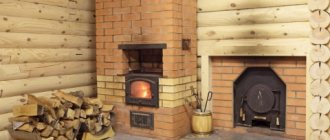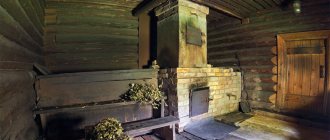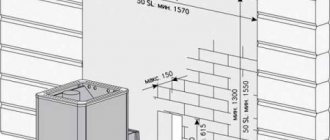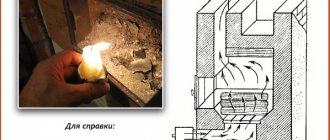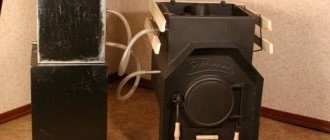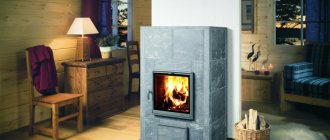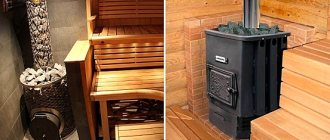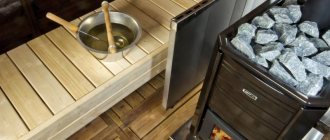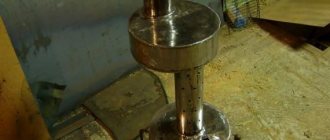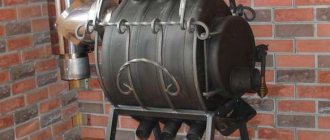Advantages of the Vesuvius cast iron stove
The unit is installed so that fuel can be supplied from the bathhouse adjacent to the steam room. It’s not for nothing that the stove is popular among steam lovers, as it has a number of undeniable advantages:
- does not undergo deformation when working at high temperatures;
- the balance of the efficiency coefficient when heating air and stones for the bath is well selected;
- the stove is produced with sufficient capacity for storing fuel;
- the door in the oven cools itself; some models have self-cleaning glass;
- refers to environmentally friendly equipment, as it is made from safe materials;
- due to its successful design, it has high strength, which makes it possible to operate the unit for a long time without breakdowns;
- compared to traditional brick analogues, it is relatively light in weight and does not require a base or foundation during installation;
- the room heats up immediately, and the stove cools down gradually, the heat is retained after 10 hours;
- installation is carried out quickly, after which the stove is immediately ready for use, if necessary, it can be moved to another place after simple dismantling;
- If it is necessary to fit the equipment into the stylish interior of the bathhouse, decorating with figured bricks or ceramics can be easily done.
Consumers liked these ovens because they conveniently use control valves to control convection flows . The stove casing does not “foul”, according to reviews from bath attendants, and the heat in the steam room of the bath reaches a temperature of 80ºC. The negative aspect of operation is that if the heater is an open type, then despite the spectacular appearance, the stones cannot heat up to the required temperature and the steam coming from them is viscous and heavy.
It should be noted that even a successful design of the outer mesh with laid stones does not create the steam for which the Russian bathhouse is famous. Therefore, to create a Russian steam bath with its characteristic temperature and high humidity, you need to install a closed stove. If you want to install an open firebox, additional devices should be made to increase efficiency.
Recommendations for use
The manufacturer of equipment for Vesuvius steam rooms prescribes recommendations for operating the device in the instructions for the models. You should familiarize yourself with them in advance and strictly follow them. This affects the service life of the device and the company’s warranty obligations. When working with company equipment, it is prohibited:
- Use peat, coke, gaseous and liquid materials as fuel. This does not comply with fire safety regulations. The combustion temperature may exceed that for which the device is designed.
- Firewood must not exceed the permissible dimensions of the firebox.
- Do not use the device if the tank is not filled with water.
- Install in residential areas for heating.
- The chimney can only be closed when the fire has completely gone out.
- Do not burn soot from the smoke duct.
- Make changes to the original design of the furnace.
Important! To prevent the destruction of cast iron, you should familiarize yourself with the rules for laying stones. You can water the stones for steam generation at a minimum interval of 5 minutes.
If these simple requirements are met, the company undertakes to eliminate all defects during the entire warranty period or replace the device free of charge.
We invite you to familiarize yourself with Do-it-yourself shelves in the bathhouse: a step-by-step guide and drawings for installing corner linden shelves
Features of the Vesuvius sauna stove
The most successful feature is the round design of the case. It is this form that ensures uniform distribution of heat rays . A sauna stove with an outer casing made of high-strength steel plates looks unusual and is recognizable by its characteristic shape. The stones in the mesh are placed evenly, thanks to this, their heating is better and at the same time the hard infrared rays from the metal walls of the firebox are extinguished.
Laying stones in an open heater can help create the atmosphere of a dry Finnish sauna, but not a Russian bathhouse. When operating an open oven, water is poured onto the heated stones. To create an atmosphere of dry steam, tubes are inserted into the stones, through which moisture and herbal infusions are supplied. Steam, falling on the lower layers of hotter stones, becomes drier, and rising through the upper layer, it becomes finely dispersed and is further dried.
So they try to bring the conditions closer to the Russian steam room, but pouring water into the tubes while standing in front of the hot surface of the heater is inconvenient, and the escaping steam prevents this from being done. It's very easy to get burned doing this kind of work. You have to place the tubes in the stones at random; if effective steam cannot be achieved, then you have to rearrange the tubes and shift the already hot stones, which is completely inconvenient.
Oven operation
Models of units with a closed firebox are more suitable for a Russian bath, but only when it is possible to regulate the temperature of the stones and the heat output by opening and closing the upper part of the stove. Some models have cases covered with silicon-organic coating to protect the case from destruction by high temperature water. Such models look stylish, but if we are talking about the possibility of making a Russian steam room, then it is better to decorate the stove with red ceramic bricks.
Furnace installation rules
Most often, the option of placing the stove in the steam room is provided, and the tank is placed in the washing compartment. A samovar-type heat exchanger is used , which does not allow heat to escape through the chimney pipe, but uses it to heat water; double action increases the efficiency of the Vesuvius stove. Experienced heating stove installers make an additional wall and fence from basalt insulation and protect it with slabs made of mineral materials.
Some bathhouse attendants modernize the “Legend” stove from the “Vesuvius” series by cutting the wire frame and making a half-brick lining, while providing upper and lower doors, but laying stones only on top.
Which stove to choose for installation in a bathhouse?
"Vertical"
The “Vertical” series of sauna stoves, unlike the “Legends”, has an unusual, memorable appearance. This is a type of unit with an open heater; all representatives of the series have the same dimensions 0.54x0.79x1.01 m. The difference lies in the decorative design of the firebox doors; they are made with glass or solid cast iron. The volume of the room that can be effectively heated by stoves of this type ranges from 8 to 18 cubic meters.
The combination of all known technologies has been successfully used in models of the “Vertical” line. The unit is equipped with an additional chamber for burning previously generated gases that appear during fuel smoldering, and double flame circulation technology has been introduced. As a result, the efficiency of the furnace is doubled. This stove, in fact, is the only model in Russian production that provides for additional heat from the combustion of released gases.
"Vesuvius"
Cast iron stoves for the Vesuvius bath, represented by the Russian Steam modification, are produced in six types for steam rooms, the volume of space in which is 18–28 cubic meters. One type is available with stone cladding. The name of the modification indicates the stove’s ability to produce steam corresponding to the atmosphere of a Russian steam room. The heater is located in the upper part; to put 60 stones into it, you need to prepare 60 stones; the unit is typically heated to 400ºC, which produces clean, light steam, fine and easy to breathe.
"Lava"
Consumers are offered the popular “Lava” models, the distinctive appearance of which is the decoration of forged elements in the body area. This modification contains 24 items that differ in power and size. Depending on this, the volume of the room ranges from 6 to 28 cubic meters. Buyers are invited to choose the presence of a combustion tunnel, a blind or panoramic firebox door. These models differ from the “Legend” in that they are equipped with a casing with ventilation and quick heating.
"Vesuvius SKIF"
The stove models from the “Vesuvius SKIF” series include 26 varieties, differing from each other in dimensions, which is why the difference in the volume of the premises ranges from 6 to 40 cubic meters. The stoves are produced with a completely welded body; prefabricated elements are not used. The combustion channel is arranged with an external structure, a retractable ash drawer. The design includes a mesh ventilation hood. The heater, like the Legend, is large in size and is designed to fill about 60 kg of stones.
The models use various decorative options for the door and body. The door is made panoramic, allowing you to admire the tongues of fire . In some options, heat-resistant glass is installed, which self-cleans and cools. Some are sold complete with a water heating tank or a special heat exchanger. It was in this modification that manufacturers combined the advantages of brick and metal heating units, using a unique and simple solution:
- a large-capacity ventilation casing is designed for a mass of stones heated to 350ºC, accumulating the resulting heat for a long time;
- the stones are placed in a casing on all sides of the stove, thus providing protection against infrared radiation, which causes a lot of trouble in equipment made of metal.
"Legend"
A striking representative of the Vesuvius line of cast iron stoves is the Legend range of units. Such equipment weighs much more than others; the mass of the assembled oven is 160 kg. “Legend” is an open heater, its combustion part has an elongated shape, the combustion tunnel allows you to heat a room with a volume of up to 28 cubic meters. The “Legend” line should not be confused with the Finnish Harvia Legend units.
"Rusich"
During the production of these stoves, the experience of domestic and foreign partners was taken into account, and device elements were selected that work effectively in sauna conditions. The result is a heater with well-organized ventilation that heats the stone mass simultaneously from all four sides in a short time. This occurs thanks to the converter casing located outside, which promotes the formation of a powerful thermal convection current. This model is the fastest oven of all types.
Operation of the stove-fireplace
Now that the firewood has been selected, you can think about lighting the sauna stove. First you need to prepare it - we will melt it later. We follow the instructions:
- We clean the grate and ash chamber (ash pan) from ash and coals;
- Wash stones in clean water;
- We determine whether there is draft (chimney permeability) necessary for carbon monoxide to escape from the stove. To do this, open the smoke valve in the chimney, the firebox and ash doors. Then we bring a lit match into the firebox and watch where the flame rushes. If it goes up, that is, it is drawn into the chimney, then everything is in order - there is draft. You can start kindling. Otherwise, you will have to first clean the chimney, since it is prohibited to heat the bathhouse without draft - the stove will “smoke”.
Do you want a gift?
80% of buyers select the wrong equipment. Leave a request for a FREE selection of a fireplace, stove, chimney taking into account all your parameters/needs. You will receive advice from a specialist who has been working in the furnace business for 15 years. AND 500 RUBLES AS A FREE!
Everyone was happy with the stove - easy to use, provides stable heat, requires little wood. True, until that moment there had been no frost, so the heating of the stove took place in the evening and that was all. An electric convector operates in standby mode and maintains the optimal temperature by morning. But, it was noticed that cast iron surfaces and fireclay in the oven give a very effective and excellent result.
Even when the wood burns out, heat continues to flow from the surface of the stove. There was no tracking by time, of course, but the indicator for the author was morning. When, after opening your eyes in the morning, you touch the stove and it is still warm - this is an excellent result. I have been convinced of this more than once by the author with the Vesuvius PK-01 stove.
Another point that was noticed during operation is that the glass smokes. In this case, the author had to clean it every day to restore its beauty, although this cleaning session takes a little time, it is still unpleasant that the stove gets dirty so quickly. If you don’t pursue beauty, you can clean the glass less often, but aesthetics are still necessary.
Among the shortcomings, I can also highlight cast iron circles for cooking - the manufacturer could have made it much better, cast these parts with more attention to the process. The second minus, already mentioned, is that the glass smokes (not exactly a minus, but there is a valuable remark).
We suggest you familiarize yourself with what kind of glue to glue polyethylene foam
The firebox of the Vesuvius PK-01 device is designed for firewood of 30-35 cm. Ordering firewood of this size is not a problem at all.
As a result, the author was pleased with the choice. You have to turn a blind eye to the shortcomings because the price is not at all high, and the stove fulfills its main tasks in full. The appearance of the stove is also satisfactory. We must wait for frost, and then it will become clear how the oven will manifest itself.
After the onset of cold weather, it became possible to evaluate the results of full operation of the device and slowly talk about the conclusions that emerged. At that time, the stove cost the author 15,300 rubles. The chimney is a little more expensive, more than 17,000 rubles. Now about the operation of the stove in severe frosts. She coped with the frost, but with great difficulty.
The point here, apparently, was the volume of the firebox. But the frosts were severe, down to -30 degrees. When choosing a stove, the author was not guided by this temperature outside the window. There was a concept that a large firebox volume in relatively warm weather would cause excessive consumption of firewood - and this is true, but the heat did not increase.
Another tile burst during use. The author tried to figure it out and it turned out that it was squeezed out by the fittings, which in turn should have strengthened the side wall of the furnace. Therefore, the sheet iron was deformed, square reinforcement was welded vertically to the entire height, but apparently the distance to the tile itself was violated.
As for the chimney, you can easily run it through the top. Here the chimney is inserted into the wall for aesthetic reasons. The author was afraid of condensation and soot when cleaning the pipe. Technologically, this is not at all difficult to do. In addition, a fireplace stove model was chosen, where the chimney exits from the back, but this choice was again made for aesthetics.
The foundation in this case was used - logs with a pitch of 350 mm, and 9mm OSB was laid on them in two layers. There is no discomfort or fear experienced.
The designs of these stoves provide two options for exhausting the chimney - back horizontally into the wall and up. The burners are provided for the option with a stove; its chimney goes back in a horizontal position, but if desired, it can also be brought up, that is, install a rotary chimney and direct the pipe upward.
This stove does not have a long-term burning mode (afterburning of secondary gases). But it is provided for in OB-7, for example, there is an owner who admits that he has never been able to set the combustion mode to long-term. According to him, he managed to withstand 4-4.5 hours of burning and no more. Here the stove burns until 6 o’clock in the morning in the evening, that is, 7 o’clock, in the evening a bookmark is made and the mode is set, which was empirically calculated to be long.
An electric convector also helps maintain the temperature on cold nights. If at night it is -14, -17, then the convector does not turn on, i.e. all the heat (about 17-20 degrees Celsius) comes from this stove. The author is completely satisfied with this. The problem with the tiles has not been solved, but it’s not a big deal and can be replaced over time.
We invite you to familiarize yourself with the Crochet washcloths for beginners master class
